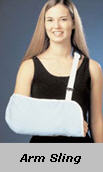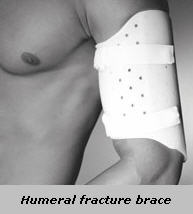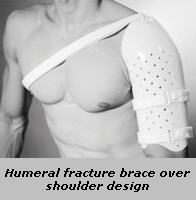
 The humerus is the bone of the upper arm which connects the elbow to the shoulder. Although multiple causes are reported, the most common cause for the humeral fracture is from a fall. The humeral fracture is normally illustrated in three injury types.
The humerus is the bone of the upper arm which connects the elbow to the shoulder. Although multiple causes are reported, the most common cause for the humeral fracture is from a fall. The humeral fracture is normally illustrated in three injury types.
§ Proximal fracture affects the area near the shoulder.
§ Mid-shaft fracture is demonstrated near the center of the bone away from the shoulder and elbow joints.
§ Distal fracture occurs near the elbow joint.
Depending on the severity of the fracture and the involvement of the shoulder or elbow joints, your physician will plan the best treat for you. In many cases, surgery may not be entertained and treatment with bracing undertaken.
 Initially, a sling can be used for support. After a period of time to be determined by your physician, a humeral orthosis can be used.
Initially, a sling can be used for support. After a period of time to be determined by your physician, a humeral orthosis can be used.
§ Consists of overlapping posterior and anterior shells fabricated with polyethylene plastic and a foam lining for comfort.
§ Easily adjustable with velcro closures
§ Allows for ROM and muscle activity that is essential for elimination of the residuals of inactivity.
§ Provides firm circumferential compression of the soft tissues to help align the fracture.
Gravity is a major component which tends to aide the alignment. After the acute stage, your physician may recommend shoulder exercises, as well as exercise of the forearm and hand to hopefully control edema and overall healing.
 ASSOCIATED CONDITIONS
ASSOCIATED CONDITIONS
§ Closed Humeral Fracture
§ Open Humeral Fracture
§ Postoperative Repair
WEARING PROTOCOL
Humeral fracture braces are worn 24/7. The brace should not be removed as this could cause bone to angulate. Care must be taken when bathing.
DON AND DOFF
§ If your physician allows you to remove the brace for bathing, replace the sock garment worn under the orthosis when reapplying.
§ Place the underarm attachment first and then place the front shell overlapping the back shell. Tighten the brace to comfort. Take care not to tighten too tight as this could lead to swelling in the area of the elbow.
§ Mark straps with tape (your orthotist will do this initially) to assure proper tightness each time brace is applied.
CARE
Due to the 24/7 wearing, most orthotists request a weekly visit for removal of the brace and the arm cleaned with alcohol and the sock garment worn under the brace replaced.
After several visits and with ongoing healing, the family should (with the physician’s permission) be able to perform this cleaning function.